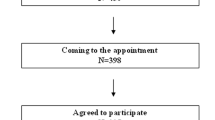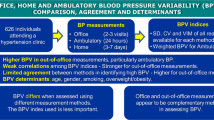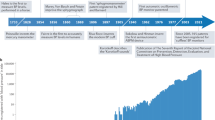Abstract
This study investigated the differences in the effect of an angiotensin converting enzyme inhibitor (ACEI) compared with an angiotensin receptor blocker (ARB) on blood pressure (BP) and pulse pressure (PP) measured in the clinic (CBP and CPP, respectively), at home (HBP, HPP) and with ambulatory monitoring (ABP, APP). Twenty-seven hypertensive patients were randomised to receive lisinopril (20 mg) or losartan (50 mg) for 5 weeks, and were subsequently crossed-over to the alternative treatment for a second 5-week period. Measurements of CBP, 24-h ABP and 5-days HBP were performed before randomisation and at the end of each treatment period. All measurement methods showed that lisinopril was more effective than losartan in reducing BP. However, the difference between the two drugs was demonstrated with greater precision using HBP (P<0.001) than 24-h ABP (P<0.01), whereas the poorest precision for demonstrating this difference was provided by CBP (P<0.05). Lisinopril was also found more effective than losartan in reducing HPP (P=0.01) and 24-h APP (P=0.03) whereas no such a difference was detected using measurements of CPP. It was concluded that the antihypertensive drugs may differ in their effects not only on BP, but also on PP. HBP monitoring appears to be as reliable as 24-h ABP monitoring in detecting differences in the effect of drugs on both BP and PP. Clinic measurements seem to be the least reliable method, particularly in the detection of differences in PP.
This is a preview of subscription content, access via your institution
Access options
Subscribe to this journal
Receive 12 digital issues and online access to articles
$119.00 per year
only $9.92 per issue
Buy this article
- Purchase on Springer Link
- Instant access to full article PDF
Prices may be subject to local taxes which are calculated during checkout


Similar content being viewed by others
References
James GD et al. The reproducibility of average ambulatory, home, and clinic pressures Hypertension 1988 1: 545–549
Stergiou GS et al. Reproducibility of home, ambulatory and clinic blood pressure: implications for the design of trials for the assessment of antihypertensive drug efficacy Am J Hypertens 2002 15: 101–104
Conway J, Coats A . Value of ambulatory blood pressure monitoring in clinical pharmacology J Hypertens 1989 7 (Suppl 3): S29–S32
Trazzi S et al. Reproducibility of non-invasive and intra-arterial blood pressure monitoring: implications for studies on antihypertensive drugs J Hypertens 1991 9: 115–119
Stergiou GS, Skeva II, Zourbaki AS, Mountokalakis TD . Self monitoring of blood pressure at home: how many measurements are needed? J Hypertens 1998 16: 725–731
Stergiou GS, Zourbaki AS, Skeva II, Mountokalakis TD . White coat effect detected using self-monitoring of blood pressure at home: comparison with ambulatory blood pressure Am J Hypertens 1998 11: 820–827
Vaur L et al. Superiority of home blood pressure measurements over office measurements for testing antihypertensive drugs Blood Press Monit 1998 3: 107–114
Asmar R et al. Pulse pressure and aortic pulse wave are markers of cardiovascular risk in hypertensive populations Am J Hypertens 2001 14: 91–97
Benetos A et al. Pulse pressure: a predictor of long-term cardiovascular mortality in a French male population Hypertension 1997 30: 1410–1415
Kostis JB et al. Association of increased pulse pressure with the development of heart failure in SHEP. Systolic Hypertension in the Elderly (SHEP) Cooperative Research Group Am J Hypertens 2001 14: 798–803
Blather J et al. Pulse pressure not mean pressure determines cardiovascular risk in older hypertensive patients Arch Intern Med 2000 160: 1085–1089
Verdecchia P et al. Ambulatory pulse pressure: a potent predictor of total cardiovascular risk in hypertension Hypertension 1998 32: 983–988
Asmar R, Lacourciere Y . A new approach to assessing antihypertensive therapy: effect of treatment on pulse pressure. Candesartan cilexetil in Hypertension Ambulatory Measurement of Blood Pressure (CHAMP) Study Investigators J Hypertens 2000 18: 1683–1690
Asmar R, Safar M, Queneau P . Evaluation of the placebo effect and reproducibility of blood pressure measurement in hypertension Am J Hypertens 2001 14: 546–552
Safar ME, Rudnichi A, Asmar R . Drug treatment of hypertension: the reduction of pulse pressure does not necessarily parallel that of systolic and diastolic blood pressure J Hypertens 2000 18: 1159–1163
O'Brien E et al. An outline of the revised British Hypertension Society protocol for the evaluation of blood pressure measuring devices J Hypertens 1993 11: 677–679
O'Brien E, Mee F, Atkins N, Thomas M . Evaluation of three devices for self-measurement of blood pressure according to the revised British Hypertension Society Protocol: the Omron HEM-705CP, Philips HP5332 and Nissei DS-175 Blood Press Monit 1996 1: 55–61
Altman DG . Analysis of crossover trials. In: Practical Statistics for Medical Research Chapman & Hall: London 1991 pp 467–471
Stergiou GS et al. Does the antihypertensive response to angiotensin converting enzyme inhibition predict the antihypertensive response of angiotensin receptor antagonism? Am J Hypertens 2001 14: 688–693
Mansoor GA, McCabe EJ, White WB . Long-term reproducibility of ambulatory blood pressure J Hypertens 1994 12: 703–708
Brueren MM et al. Is a series of blood pressure measurements by the general practitioner or the patient a reliable alternative to ambulatory blood pressure measurements? A study in general practice with reference to short-term and long-term between-visit variability Am J Hypertens 1997 10: 879–885
Chatellier G et al. Home self blood pressure measurement in general practice: the SMART study Am J Hypertens 1996 9: 644–652
Chatellier G, Day M, Bodrie G, Menard J . Feasibility study of n-of-l trials with blood pressure self-monitoring in hypertension Hypertension 1995 25: 294–301
Madhavan S, Ooi WL, Cohen H, Alderman MH . Relation of pulse pressure and blood pressure reduction to the incidence of myocardial infarction Hypertension 1994 23: 395–401
Stergiou GS et al. Clinic, home and ambulatory pulse pressure: comparison and reproducibility J Hypertens 2002 in press
MacMahon S et al. Blood pressure, stroke, and coronary heart disease. Part 1, prolonged differences in blood pressure: prospective observation studies corrected for the regression dilution bias Lancet 1990 335: 827–838
James MA et al. Pulse pressure and resistance artery structure in the elderly Hypertension 1995 26: 301–306
Bumier M, Brunner HR . Angiotensin II receptor antagonists Lancet 2000 355: 637–645
Stergiou GS et al. Additive hypotensive effect of angiotensin converting enzyme inhibition and angiotensin receptor antagonism in essential hypertension J Cardiovasc Pharmacol 2000 35: 937–941
O'Rourke MF . Arterial mechanics and wave reflection with antihypertensive therapy J Hypertens 1992 10: S43–S49
Safar ME . Pulse pressure in essential hypertension: clinical and therapeutic implications J Hypertens 1989 7: 769–776
Klemsdal TO, Moan A, Kjeldsen SE . Effects of selective angiotensin II type 1 receptor blockade with losartan on arterial compliance in patients with mild essential hypertension Blood Press 1999 8: 214–219
Safar ME et al. Pulse pressure in sustained essential hypertension: a hemodynamic study J Hypertens 1987 5: 213–218
Author information
Authors and Affiliations
Corresponding author
Rights and permissions
About this article
Cite this article
Stergiou, G., Efstathiou, S., Skeva, I. et al. Assessment of drug effects on blood pressure and pulse pressure using clinic, home and ambulatory measurements. J Hum Hypertens 16, 729–735 (2002). https://doi.org/10.1038/sj.jhh.1001477
Received:
Revised:
Accepted:
Published:
Issue Date:
DOI: https://doi.org/10.1038/sj.jhh.1001477
Keywords
This article is cited by
-
Home Blood Pressure Monitoring in the Diagnosis and Treatment of Hypertension: A Systematic Review
American Journal of Hypertension (2011)
-
Angiotensin receptor blockade in the challenging era of systolic hypertension
Journal of Human Hypertension (2004)



